 |
|
Thatch and roots...
Michael Stachowicz, Dedham Country and Polo Club, Dedham, MA:
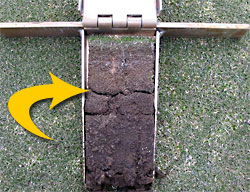  "Eight seasons ago I took a walk on this golf course. Having just started here, I wondered what I had gotten myself into. I took a soil profile from the twelfth green and my heart sank. One can see in the picture the crack in the thatch/soil interface... this is where the roots stopped.
There was what seemed to be an insurmountable amount of thatch in the greens (2 inches plus) and roots that did not exist below that thatch layer. The golf course had a history of disease and root-feeding nematodes, and I was wondering how I was going to get through a season without enough rooting to feed the nematodes and the turf. On top of that, thatch becomes a sponge in wet conditions, promoting diseases like root rot pythium that reduce viable roots even further. Thatch also affects the playability of the course by making green speeds harder to achieve and will cause the plugging of balls. There was no doubt that this two inch layer was going to have to go... but this was daunting. Finding a way to eliminate this type of layer without adversely affecting playability on a regular basis seemed herculean.
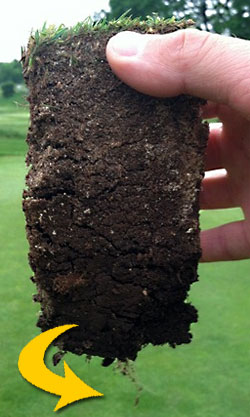
I am not going to espouse any wonder cure for this; it only took persistence. Agronomically, we knew what needed to get done. We needed to topdress with sand and make holes. We also needed to adopt a fertility and watering program that didn't add more thatch. The Monday mornings where we are allowed to do maintenance to the course has been a key to our battle with this. We found new ways to make holes (aerate) and incorporate sand. We stayed on a steady program and did not sway from it... we needed to affect 15% to 20% of the surface annually.
The picture to the right shows that the thatch layer has been eliminated, there is over 2" of sand under the turf, and roots down about five inches (6" to 7" if you look closely below the soil). The tensile strength of these roots is pretty good to hold this profile together. In short, we are really pleased with the roots we have for the upcoming summer. We still have nematodes to worry about, but the roots have their best chance yet of minimizing the damage from them.
"Every time something gets skipped, it pushes the end goal off a little bit further or lets disaster one step closer..." |
Maintaining a golf course is like a fitness program. It is always easier to skip an incremental practice than do it. It is easy to think that your body won't notice it if you skip one trip to the gym, or if you skip an oil change for your car... all small actions that seem to have no repercussions. But they do matter in the long term. Every time something gets skipped, it pushes the end goal off a little bit further or lets disaster one step closer (car failure, heart attack, thatch development). It is important to stay true to what you know is needed, stay on a regular program of health and maintenance for your health, your car, your relationships, your house, and your greens.
Visit Michael's blog at mstachowicz.wordpress.com
|
 |
|
Poa annua under fire...
Sean McCue, Country Club at Castle Pines, Castle Rock, CO:
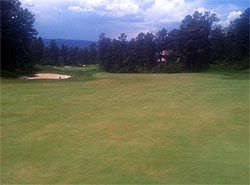  "Over the years we have used many different products to try and control Poa Annua, each with varying degrees of success.
Currently we are testing a newly labeled product called Xonerate for Poa annua control. We began our testing on several areas of the golf course including #11 first fairway, 1/2 of #11 green, North chipping and nursery greens and fairways.
"I am happy about the Poa being under stress... not so much with the bent." |
After closely following the application protocols over the last six weeks visual disruption is taking place on some of the turf areas. Most notably the first fairway on hole #11 is showing signs of both Poa annua stress as well as some Bentgrass stress. I am happy about the Poa being under stress, not so much with the bent. Most of the damage to the Bent is in the form of leaf tip burn and or stress. The crown of the plant still looks healthly and active. Over the next several weeks the plant should push out new leaf material and the visual disruption will recede.
It is exciting to see new products come to the market, but if they are not safe on the desired plant species then it really doesn't help my overall battle against Poa annua.
Visit Sean's blog at cccpgcm.blogspot.com.
|
 |
|
Pinestraw crew...
Owen Coulson, Vestavia Country Club, Birmingham, AL:
"Over the last few years we have contracted out our pinestraw spreading to Southeastern Spreading. They have many clients up and down the East Coast and down all throughout Florida. We were their first golf course client in Alabama a few years ago and now that list of golf courses has grown in large part due to the final product they can deliver at an unbeatable price.
"Because this was 'extra' work after all other tasks were completed, it usually was overtime labor as well..." |
Pinestraw spreading was something that our normal crew did in the afternoon each day and would take at least a week (usually more) to complete the entire property, and we did it about three times every year. Because this was 'extra' work after all other tasks were completed, it usually was overtime labor as well.
Southeast Spreading comes in and spreads our entire golf course in one day. The best part of the process though, is that when they leave everything is very clean and every edge is neatly cut into place."
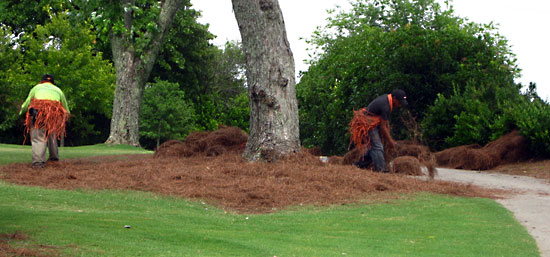
You can see the bale string tied around their waist.
|
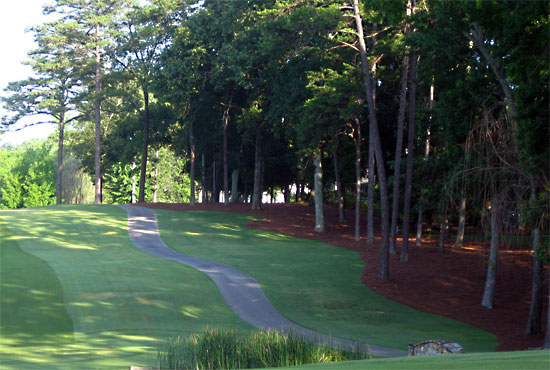
Right side of #2 rough has no irrigation so pinestraw will look a lot better than bare ground here.
|
Visit Owen's blog at vccturfgrass.blogspot.com.
|
 |
|
Annual bluegrass...
Steve Cook, CGCS MG, Oakland Hills Country Club, Bloomfield Hills, MI:
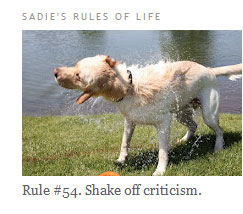  "Annual Bluegrass (Poa annua) is a native of Europe and is found worldwide. 'Poa', as most members refer to it, likes moist, shady sites and prefers rich, compacted soils. These conditions are typically found on older golf courses and greens like the South Course.
The South greens are original Donald Ross greens (except #s 7,8,15,12) and are composed of organic soils amended by many years of topdressing with sand. The North Course greens were rebuilt by Robert Trent Jones in 1969, seeded with Penncross bentgrass, and have soils with a high percentage of sand. The North greens have good internal drainage.
"...but with large areas of bare turf on putting greens, the superintendent is often eliminated as well. Therefore, we choose not to use herbicides." |
Annual Bluegrass is a prolific seed producer and with the ability to survive in hostile environments, can quickly establish itself in greens, tees and fairways. A small plant can produce up to 100 seeds. These seeds can germinate rapidly and with the ability to survive under very close mowing heights, can overtake a green surface in a few years.
Once established, it is extremely difficult to control and still maintain quality putting surfaces. Some herbicides are available to eliminate annual bluegrass... but with large areas of bare turf on putting greens, the superintendent is often eliminated as well. Therefore, we choose not to use herbicides."
Visit Steve's blog at ohccturf.blogspot.com/
|
 |
|
The hardest decision...
Ken Thompson, Greate Bay Country Club, Somers Point, NJ:

"Probably the hardest decision I make is after a rain storm, and whether or not to make the course 'cart paths only'. I know that it slows play. I know too that it hurts revenue and increases the cost of course set up and labor since rangers need to come in, ropes moved, and signs put out. I know all too well that some members are unable to play when they can't take their carts onto the fairways or through the rough. All carts are capable of causing damage, so those persons with physical disabilities must stay on cart paths too.
"I try to balance the short and long term effects on both the membership and the course, and I always do my best to look after both. It's not easy..." |
Yet, I also know the damages — both short and long term — which traffic can cause on wet soils. Without getting boringly technical, a saturated soil can be compacted without very much pressure, and when this happens, drainage, root space, air space, etc are reduced or lost. The turf grows weak, and weak turf is prone to moisture stress and disease. The risk of future turf loss is substantially increased. The problem is that loss of turf shows up later, which may be days, weeks, or months away from the initial event. By then, everyone has long forgotten the rainy day I let carts out.
Another factor is disease. Fungi flourish in wet environments, and can be tracked or carried down a fairway or through the rough on tires (our equipment as well as carts)! One infection, uncontained, can be spread. Some diseases, such as pythium, can kill turf within minutes of infection, and then spread by water and traffic, can easily become uncontrollable and devastate the course.
When I make the cart path decision, I try to balance the short and long term effects on both the membership and the course, and I always do my best to look after both. It's not easy, and though some members will always disagree, I am always trying to do the right thing.
There is no reason to take it out on me, as some do."
Visit Ken's blog at greatebaycc.blogspot.com.
|
 |
|
Soil moisture and green speed...
Patrick Daly, CGCS, Framingham Country Club, Framingham, MA:
 "We are starting to get tired of this rain. If you think it seems like it's been raining every day, it has. Yesterday we received a quick shower around noon and showers after 3 p.m., adding 0.3" of rain and bringing the week's total close to 3". We have continued to roll throughout the rain and continue to lower cutting heights, chasing green speed. It has been frustrating and unfortunately the greens are wet and although they are putting smooth, they will continue to be slow until the soil moisture drops.
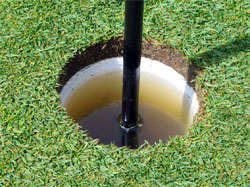 What is our soil moisture like? To the right is a photo taken earlier this morning.
The volumetric content reading obtained today from our soil moisture meters averages 32%. That is significantly higher than the readings of 18-20% that we were taking this spring when the greens were dry and speeds were at acceptable levels.
We are able to provide decent speed on the greens when the weather is cooler and dry and the grass leaf blades are thinner, limiting friction between the ball and the grass as it rolls across the green. When the weather is warm and humid with high moisture the leaf blade becomes thick and friction increases between the ball and the grass as it rolls across the green.
Storms are forecasted for this afternoon and hopefully that's the last of it before becoming dry Saturday thru Tuesday. We are scheduled to groom the greens and lower mowing heights again on Monday as we prepare for the Hargraves next week. We will also start double cutting next week and hopefully speeds will pick up. Needless to say it's important to fix your ball marks with during this period of excessive moisture."
Visit Pat's blog at fccgrounds.blogspot.com.
|
 |
|
The Doctor is IN...
Doug Ayres, Corral de Tierra Country Club, Salinas, CA:
 | (Wired and Crazy Tournament logo painted on the first tee)
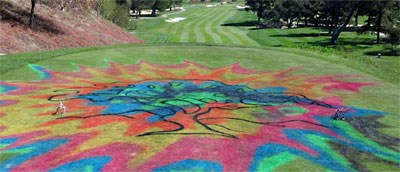
When you get wired and crazy... |
(California Women's Amateur Championship logo, CWAC) 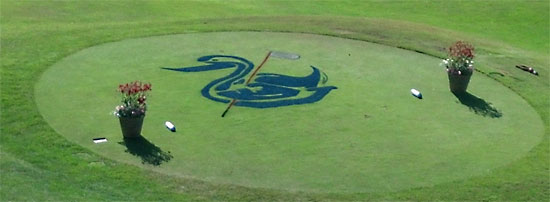 You could go see a quack and get some advice to medicate...
(Latest product for turf: Aspirin. If it is good for you, it is good for the turf.) 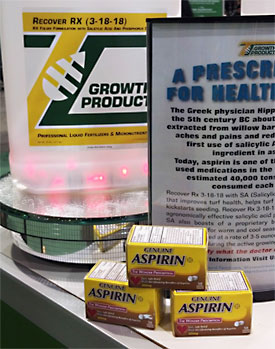 Take two of these and call me in the morning, he will say.
(Monterey County Vintners' logo for recent tournament.) 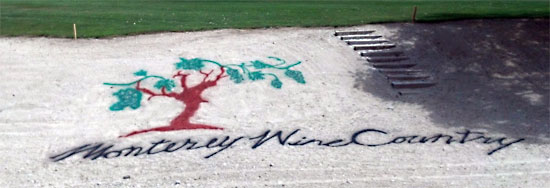 Or you could just drink a bottle of wine.
Visit Doug's blog at corralmaintenance.blogspot.com.
|
 |
 |
|
About our Blog Aggregator: Many superintendents are now hosting private blogs to better communicate with their golfers and/or members. Beyond local weather and course conditions, there is a great deal of information about projects, methodologies and techniques that would be of value to other superintendents — hence our Turf Blog Aggregator. As every blogger struggles occasionally with content, we also include posts intended to educate golfers about turf maintenance for others to use as a template for their own blogs.
Miss any previous issues of TBA? You can find them all here.
Turf Blog Aggregator(TM) is a trademark of Turnstile Media Group.
|
|